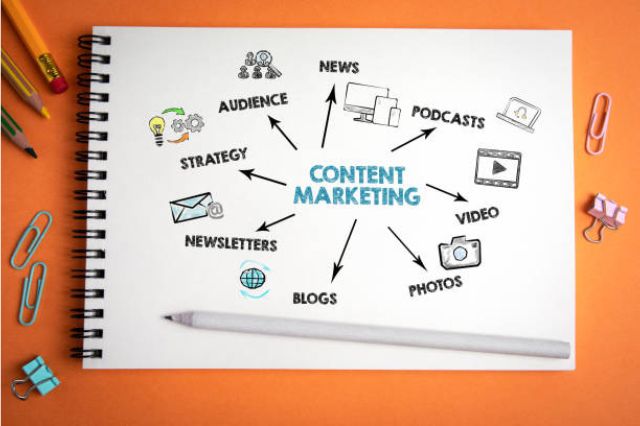The Ultimate Guide to Content Marketing: Fueling Your Business Growth

Content marketing refers to creating and distributing various types of media content to engage potential customers and drive profitable actions. This content aims to inform, assist, entertain, or otherwise deliver value to attract an audience while promoting products or services.
Unlike traditional product-centric advertising, content marketing aims to build relationships with buyers through helpful information rather than hard sales. Formats span blog posts, videos, visual guides, podcasts, and more, with a defining goal of nurturing audiences to become brand loyalists.
Businesses that successfully develop content marketing strategies focused on regularly publishing high-quality, relevant media reap immense rewards in brand visibility, website traffic, lead generation, and sales over time as their following grows through resonance.
Why is Content Marketing Important?
Let’s explore critical reasons content marketing should be a crucial component of any modern digital marketing strategy:
Builds Brand Awareness and Trust
Content showcases a company’s expertise in solving customers’ problems. Demonstrating understanding through consistent media builds familiarity and trust in the brand over time, nurturing sales.
Attracts and Engages Target Audiences
Optimized content appears prominently in search and social feeds catching the attention of ideal prospects already seeking related topics and converting them into regular engaged followers through relevance and value.
Drives Organic Traffic
High-quality content earns prominent display on search engines and platforms, increasing visitors without paid ads which builds volumes of recurring organic traffic via viewer shares allowing content amplification.
Generates Leads and Conversions
Calls-to-action, gated offers, and forms integrated into content facilitate lead capture for ongoing conversion nurturing through sales funnels translating visitors into quantified pipeline value.
Cost-Effective Marketing
Rather than constantly paying to re-target brief website visitors, content marketing provides durable assets that continually generate traffic, leads, and sales years after initial publication with minimal recurring costs.
Supports Overall Marketing Efforts
The content aligns and often enhances the results of additional marketing channels, from paid search landing page conversions to trade publication relations offering more touchpoints through different discovery paths.
Executing content initiatives focused on informing over promoting products gives companies an extremely adaptable growth lever producing manifold benefits.
Also read:
- 4 Tips to Improve Your Content Marketing Strategy
- 8 Content Marketing Mistakes You Must Avoid
- The Psychology of Consumer Behaviour: Insights for Effective Marketing Campaigns
The Benefits of Content Marketing
Now that the fundamentals of content marketing establish why it should command focus within business marketing plans let’s explore the tangible benefits realized:
Increased Brand Visibility and Reach
Optimized content surfaces prominently on influential media sites, search engines, and social feeds expanding brand discovery by exponentially larger qualified audiences.
Improved Search Engine Rankings
Constant creation of high-quality keyword-optimized blogging fosters search engine authority helping company pages place within critical top slots for a wider variety of relevant customer queries.
Enhanced Brand Authority and Trust
Prolific publishing signals to customers a trusted brand investing extensively in understanding buyer needs rather than just profiting from cursory product proliferation.
Increased Website Traffic
Compelling ideation multiplies referrals to company sites through readers sharing evergreen content unmatched by brief conventional advertising exposure driving more quality visitor growth sustainably over multi-month periods.
Lead Generation and Nurturing
Integrated call-to-action placement throughout content combined with lead capture offerings (such as gated eBooks/webinars) reliably converts visitors into qualified sales prospects for tailored follow-up while sustaining awareness through regular value delivery, nurturing future buying decisions.
Improved Customer Engagement and Retention
Current customer retention strengthens through consistently providing evergreen content resolving pain points around product applications rather than just focusing on sales acquisition thereby reducing customer churn.
Cost-Effective Marketing
Content creation carries minimal outlay compared to paid search advertising or print campaigns translating into significantly higher ROI over multiyear horizons as evergreen assets continually multiply exposure via recurring organic traffic, referral links, and social shares.
Measurable Results
Digital analytics integration with content tracking visitor metrics tied to conversions enables precise measurement of content performance in generating leads/sales determining ideal creative direction and content types to amplify.
These measurable benefits explain why over three-quarters of companies now embrace some form of content marketing fused deeply within their business expansion strategies in the digital age.
Key Components of a Successful Content Marketing Strategy
While creative ideation represents the visible facade captivating audiences, structurally sound content strategies also hinge on critical foundations, including:
Defining Target Audiences
Persona-defining demographics like buyer roles, pain points, and product application styles shape content themes and messaging tailored to distinctly resonate with readership segments.
Setting Goals and Objectives
Content initiatives require executive buy-in on business objectives tied to metrics like lead volume, traffic levels, and conversion rates for analytics tracking gauging impact over specified timeframes.
Conducting Keyword Research
High-value search phrases with relevant average monthly search volumes identify oft-searched problems for which strategically optimized and interlinked content captures consumer demand.
Creating an Editorial Content Calendar
An editorial calendar plotting detailed future content across diverse formats, topics, and promotion timelines provides consistency in publishing to engagement rhythm.
Developing High-Quality Content
Well-researched, extensively optimized content in different formats performs exponentially better for engagement than short-form glossing blog posts, as pillar content earns trust.
Promoting Released Content
Multi-channel content promotion through owned e-newsletters, social media, paid ads, and influencer campaigns broaden visibility rather than expecting visitors to organically find new content.
Tracking Performance Metrics
Platform analytics integration tied to lead generation metrics gauges content resonance helping creative refinement, and informs forward content pipelines through data signals on popular topics.
Investing equally across infrastructure scalability, topic research, creative talent, and analytic monitoring ensures substantial ROI from content programs through durable visibility.
Also read:
- How to Easily Make Money with Content Marketing
- Meme Marketing: What is it and How to Use it
- Dynamic Marketing: Exploring the Benefits of Motion Graphics in Content Strategy
Types of Content Marketing
Myriad content formats now permeate multi-channel web journeys. Optimizing appropriately for each channel and even blending media expands engagement opportunities.
- Blogs – Quick-hit news or education-sustaining readership.
- Articles – Trend perspectives or listicles attracting casual searches.
- Videos – Demo summaries or animated explainers simplify decisions through showcasing.
- Infographics – Visual asset simplifying complex themes and boosting shareability.
- Social Media – Channel content to follower bases broadening reach.
- eBooks / Guides – Lead magnet gated assets educating motivated prospects.
- Whitepapers – Data-backed validation building credibility for later sales cycles.
- Case Studies – Problem/resolution customer stories prove concepts in action, de risking solutions.
- Webinars / Events– Thought leadership and community cultivated through digital gatherings.
- Podcasts – Expanded visibility and trust via personally conveyed stories.
This diversity allows matching distinct content types to required outcomes across the buyer journey nurturing customers through education towards purchases.
Measuring Content Marketing Success
While creativity steers ideation, data signals guide strategy refinement to continually boost measurable impact across key metrics:
Website Traffic – Overall visitor volumes across pages/segments highlight content resonance.
Social Media Engagement – Shares, clicks, and conversations extend messages into new networks.
Lead Generation – Opt-in rates for gated content offers and trial signups assess interest conversion.
Online/Offline Conversions – Web sales or phone call inquiry attitudes convey bottom-line impact.
Brand Awareness Lift – Surveys gauge brand familiarity and attribute perceptions over time.
Customer Engagement – Readership loyalty is measured by repeat visits, page depth, and subscriber list signal uptake.
Un/Subscription Rates – Selected email newsletter signups/cancellations indicate retainable content interest.
Monitoring analytics dashboards tracking key indicators tied to content development initiatives and iterations helps steer the creative direction and formats toward demonstrable business growth.
Content Marketing Best Practices
Maximizing content success involves upholding processes supporting enduring quality and resonance. Consider adopting content marketing program practices like:
- Quality Over Quantity – One exemplary in-depth guide outperforms 10 shorter superficial posts diluting expertise.
- Consistency – Establish publishing cadences (such as 2X per month), organically building anticipation through dependability.
- Distribution Promotion – Allocate a minimum of 20% of content budgets towards amplification driving visibility through social media, email, and partnerships.
- Audience Engagement – Polls, surveys, and open-ended commentary foster community while guiding strategy reactions.
- Continuous Iteration – Analyze performance frequently to double down on well-performing themes and formats while eliminating poor-responsiveness content.
- Embracing Trends – Align forward editorial calendars to leverage zeitgeist moments, captivating exposure chances through relevance.
Upholding production pillars around memorable messaging, aesthetic visuals, and structured processes manifests flourishing content marketing returns over the long term.
Conclusion
Content marketing is a powerful tool for businesses looking to attract, engage, and retain customers in the digital age. By creating valuable, relevant content and strategically distributing it, you can build brand awareness, establish trust, and drive business growth.
Remember, successful content marketing is not about quick wins but about building long-term relationships with your audience. It requires patience, consistency, and a willingness to continuously learn and adapt.
The post The Ultimate Guide to Content Marketing: Fueling Your Business Growth appeared first on The Total Entrepreneurs.
If you re eager to discover more about how we can elevate your digital presence, don t hesitate to explore our full range of services. Click on the link below to delve into a world of tailored strategies, innovative solutions, and a dedicated team ready to amplify your online impact. Your digital success story starts here.
Explore Our Services





